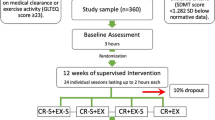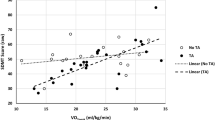Abstract
Introduction
Cognitive impairment is common and debilitating among persons with multiple sclerosis (MS) and might be managed with exercise training. However, the effects of exercise training on viscoelastic brain properties in this population are unknown. The present pilot study adopted a single-blind randomized controlled trial (RCT) design and is the first to examine the effect of an aerobic exercise training intervention on learning and memory and hippocampal viscoelasticity using magnetic resonance elastography (MRE) in persons with MS.
Methods
Eight fully ambulatory females with MS were randomly assigned into exercise training intervention or waitlist control conditions. The intervention condition involved 12 weeks of supervised, progressive treadmill walking exercise training. All participants underwent measures of learning and memory (i.e., California Verbal Learning Test-II; CVLT-II) and further underwent MRE scans for measurement of shear stiffness (μ) and damping ratio (ξ) of the hippocampus before and after the 12-week period.
Results
Overall, there were small-to-moderate intervention effects on CVLT-II performance (d = 0.34) and large intervention effects on hippocampal μ (d = 0.94) and hippocampal ξ (d = −1.20). Change in CVLT-II scores was strongly associated with change in μ (r = 0.93, p < 0.01) and ξ (r = −.96, p < 0.01) of the hippocampus.
Conclusion
This small pilot RCT provides exciting proof-of-concept data supporting progressive treadmill walking exercise training for potentially improving learning and memory and underlying hippocampal viscoelastic properties in persons with MS. This is important given the high prevalence and burden of MS-related memory impairment.


Similar content being viewed by others
References
Chiaravalloti ND, DeLuca J (2008) Cognitive impairment in multiple sclerosis. Lancet Neurol 7:1139–1151
Chiaravalloti ND, Wylie G, Leavitt V, DeLuca J (2012) Increased cerebral activation after behavioral treatment for memory deficits in MS. J Neurol 259:1337–1346
Chiaravalloti ND, Moore NB, Nikelshpur OM, DeLuca J (2013) An RCT to treat learning impairment in multiple sclerosis: the MEMREHAB trial. Neurology 81:2066–2072
Motl RW, Sandroff BM, Benedict RHB (2011) Cognitive dysfunction and multiple sclerosis: developing a rationale for considering the efficacy of exercise training. Mult Scler 17(9):1034–1040
Sandroff BM (2015) Exercise and cognition in multiple sclerosis: the importance of acute exercise for developing better interventions. Neurosci Biobehav Rev 59:173–183
Voss MW, Nagamatsu LS, Liu-Ambrose T, Kramer AF (2011) Exercise, brain, and cognition across the life span. J Appl Physiol 111:1505–1513
Leavitt VM, Cirnigliaro C, Cohen A, Farag A, Brooks M, Wecht J et al (2014) Aerobic exercise increases hippocampal volume and improves memory in multiple sclerosis: preliminary findings. Neurocase 20(6):695–697
Muthupillai R, Lomas DJ, Rossman PJ, Greenleaf JF, Manduca A, Ehman RL (1995) Magnetic resonance elastography by direct visualization of propagating acoustic strain waves. Science 269:1854–1857
Manduca A, Oliphant TE, Dresner MA, Mahowald JL, Kruse SA, Amromin E et al (2001) Magnetic resonance elastography: non-invasive mapping of tissue elasticity. Med Image Anal 5:237–254
Sack I, Jöhrens K, Wuerfel J, Braun J (2013) Structure-sensitive elastography: on the viscoelastic powerlaw behavior of in vivo human tissue in health and disease. Soft Matter 9:5672–5680
Hiscox LV, Johnson CL, Barnhill E, McGarry MDJ, Huston J, van Beek EJR, et al. (in press) Magnetic resonance elastography (MRE) of the human brain: technique, findings and clinical applications. Phys Med Biol
Murphy MC, Huston J, Jack CR, Glaser KJ, Manduca A, Felmlee JP, Ehman RL (2011) Decreased brain stiffness in Alzheimer’s disease determined by magnetic resonance elastography. J Magn Reson Imaging 34:494–498
Romano AJ, Guo J, Prokscha T, Meyer T, Hirsch S, Braun J et al (2014) In vivo waveguide elastography: effects of neurodegeneration in patients with amyotrophic lateral sclerosis. Magn Reson Med 72:1755–1761
Streitberger K-J, Sack I, Krefting D, Pfüller C, Braun J, Paul F, Wuerfel J (2012) Brain viscoelasticity alteration in chronic-progressive multiple sclerosis. PLoS One 7:e29888
Wuerfel J, Paul F, Beierbach B, Hamhaber U, Klatt D, Papazoglou S et al (2010) MR-elastography reveals degradation of tissue integrity in multiple sclerosis. Neuro Image 49:2520–2525
Fehlner A, Behrens JR, Streitberger K-J, Papazoglou S, Braun J, Bellmann-Strobl J et al (2015) Higher-resolution MR elastography reveals early mechanical signatures of neuroinflammation in patients with clinically isolated syndrome. J Magn Reson Imaging. doi:10.1002/jmri.25129
Enzinger C, Barkhof F, Ciccarelli O, Filippi M, Kappos L, Rocca MA et al (2015) Nonconventional MRI and microstructural cerebral changes in multiple sclerosis. Nat Rev Neurol 11(12):676–686
Johnson CL, McGarry MDJ, Van Houten EEW, Weaver JB, Paulsen KD, Sutton BP, Georgiadis JG (2013) Magnetic resonance elastography of the brain using multishot spiral readouts with self-navigated motion correction. Magn Reson Med 70:404–412
Johnson CL, Holtrop JL, McGarry MDJ, Weaver JB, Paulsen KD, Georgiadis JG, Sutton BP (2014) 3D multislab, multishot acquisition for fast, whole-brain MR elastography with high signal-to-noise efficiency. Magn Reson Med 71:477–485
Johnson CL, McGarry MDJ, Gharibans AA, Weaver JB, Paulsen KD, Wang H et al (2013) Local mechanical properties of white matter structures in the human brain. Neuro Image 79:145–152
Johnson CL, Schwarb H, McGarry MDJ, Anderson AT, Huesmann GR, Sutton BP, Cohen NJ (2016) Viscoelasticity of subcortical gray matter structures. Hum Brain Mapp. doi:10.1002/hbm.23314
Schwarb H, Johnson CL, McGarry MDJ, Cohen NJ (2016) Medial temporal lobe viscoelasticity and relational memory performance. Neuro Image 132:534–541
Sandroff BM, Balto JM, Klaren RE, Sommer SK, DeLuca J, Motl RW (in press) Systematically-developed pilot randomized controlled trial of exercise and cognition in persons with multiple sclerosis. Neurocase
Thomas S, Reading J, Shephard RJ (1992) Revision of the physical activity readiness questionnaire. Can J Sport Sci 17:338–345
Delis DC, Kramer JH, Kaplan E, Ober BA (2000) California Verbal Learning Test, Second edition (CVLT-II). Psychological Corporation, San Antonio, TX
McGarry MDJ, Van Houten EEW, Johnson CL, Georgiadis JG, Sutton BP, Weaver JB, Paulsen KD (2012) Multiresolution MR elastography using nonlinear inversion. Med Phys 39:6388–6396
McGarry MDJ, Johnson CL, Sutton BP, Van Houten EEW, Georgiadis JG, Weaver JB, Paulsen KD (2013) Including spatial information in nonlinear inversion MR elastography using soft prior regularization. IEEE Trans Med Imaging 32:1901–1909
Patenaude B, Smith SM, Kennedy DN, Jenkinson M (2011) A Bayesian model of shape and appearance for subcortical brain segmentation. Neuro Image 56:907–922
Jenkinson M, Beckmann CF, Behrens TEJ, Woolrich MW, Smith SM (2012) FSL. Neuro Image 62:782–790
McGarry MDJ, Van Houten EEW (2008) Use of a Rayleigh damping model in elastography. Med Biol Eng Comput 46:759–766
Kurtzke JF (1983) Rating neurologic impairment in multiple sclerosis: an expanded disability status scale (EDSS). Neurology 33:1444–1452
American College of Sports Medicine (2013) ACSM’s resource manual for guidelines for exercise testing and prescription, 7th edn. Lippincott Williams & Wilkins, Philadelphia (PA)
Sandroff BM, Hillman CH, Benedict RHB, Motl RW (2015) Acute effects of walking, cycling, and yoga exercise on cognition in persons with relapsing-remitting multiple sclerosis without impaired cognitive processing speed. J Clin Exp Neuropsychol 37(2):209–219
Cohen J (1988) Statistical power analysis for the behavioral sciences, 2nd edn. Lawrence Erlbaum Associates, Hillsdale (NJ)
Rutledge T, Loh C (2004) Effect sizes and statistical testing in the determination of clinical significances in behavioral medicine research. Ann Behav Med 27:138–145
Parmenter BA, Testa SM, Schretlen DJ, Weinstock-Guttman B, Benedict RHB (2009) The utility of regression-based norms in interpreting the minimal assessment of cognitive function in multiple sclerosis (MACFIMS). J Int Neuropsychol Soc 6:6–16
Erickson KI, Voss MW, Prakash RS, Basak C, Szabo A, Chaddock L et al (2011) Exercise training increases size of hippocampus and improves memory. Proc Natl Acad Sci U S A 108(7):3017–3022
Mohr DC, Spring B, Freedland KE, Beckner V, Arean P, Hollon SD et al (2009) The selection and design of control conditions for randomized controlled trials of psychological interventions. Psychother Psychosom 78:275–284
Ehlers DK, Fanning J, Awick EA, Kramer AF, McAuley E (2016) Contamination by an active control condition in a randomized exercise trial. PLoS One 11(10):e016426
De Giglio L, Tona F, De Luca F, Petsas N, Prosperini L, Bianchi V et al (2016) Multiple sclerosis: changes in thalamic resting-state functional connectivity induced by a home-based cognitive rehabilitation program. Radiology 280(1):202–211
Sandroff BM, Pilutti LA, Benedict RHB, Motl RW (2015) Association between physical fitness and cognitive function in multiple sclerosis: does disability status matter? Neurorehabil Neural Repair 29(3):214–223
Acknowledgements
MRE data acquisition and analysis was partially supported by NMSS grant IL-1503-03395 and NIH/NIBIB grants R01-EB018320 and R01-001981. This research is additionally part of the Blue Waters sustained-petascale computing project, which is supported by the National Science Foundation + University of Illinois at Urbana-Champaign and its National Center for Supercomputing Applications.
Author information
Authors and Affiliations
Corresponding author
Ethics declarations
We declare that all human and animal studies have been approved by the University of Illinois Institutional Review Board and have therefore been performed in accordance with the ethical standards laid down in the 1964 Declaration of Helsinki and its later amendments. We declare that all patients gave informed consent prior to inclusion in this study.
Conflict of interest
We declare that we have no conflict of interest.
Rights and permissions
About this article
Cite this article
Sandroff, B.M., Johnson, C.L. & Motl, R.W. Exercise training effects on memory and hippocampal viscoelasticity in multiple sclerosis: a novel application of magnetic resonance elastography. Neuroradiology 59, 61–67 (2017). https://doi.org/10.1007/s00234-016-1767-x
Received:
Accepted:
Published:
Issue Date:
DOI: https://doi.org/10.1007/s00234-016-1767-x




